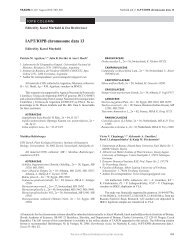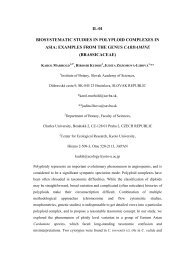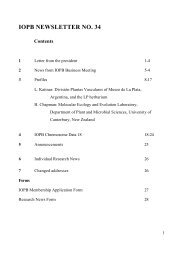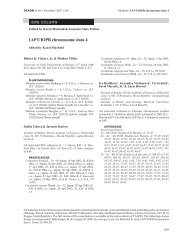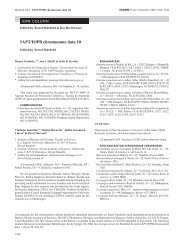CONTENS - International Organization of Plant Biosystematists
CONTENS - International Organization of Plant Biosystematists
CONTENS - International Organization of Plant Biosystematists
Create successful ePaper yourself
Turn your PDF publications into a flip-book with our unique Google optimized e-Paper software.
ECOLOGICAL FACTORS IN PLANT EVOLUTION<br />
O 37<br />
Population differentiaton, local adaptation and gene flow in the<br />
alpine landscape<br />
Jürg Stöcklin<br />
Botanical Institute, University <strong>of</strong> Basel, Schönbeinstrasse 6, CH-4056 Basel,<br />
Switzerland. E-mail: juerg.stoecklin@unibas.ch<br />
Steep environmental gradients and patchy habitats characterize alpine environments.<br />
Life conditions change dramatically with altitude, exposition, snow cover or<br />
succession. As a consequence, shifts in selection pressure are to be expected.<br />
Spatial isolation and limited gene flow are the rule for alpine plants, and<br />
differentiation might also result from small population size and genetic drift.<br />
Furthermore, most alpine areas include cultural landscapes; agricultural land use has<br />
considerably added to the natural diversity <strong>of</strong> alpine habitats. The characteristics <strong>of</strong><br />
alpine environments are well known but consequences for evolutionary processes<br />
are still poorly understood. Here I present case studies <strong>of</strong> alpine plant species to<br />
answer the following general questions. Does genetic diversity decrease with<br />
altitude? How is genetic diversity distributed within and among populations and by<br />
what factors is it affected? How important is population differentiation in important<br />
liefe history traits? Is selection pressure strong enough for pronounced adaptation<br />
along ecological gradients? Genetic diversity was found to be generally high, and<br />
genetic differentiation was not particularly pronounced, but increasing with<br />
geographic distance in all studied cases. Results suggest considerable genetic drift<br />
among populations <strong>of</strong> alpine plants, but it is not high enough to mask genetic imprints<br />
<strong>of</strong> glacial history. Adaptive trait differentiation was observed due to altitude and as a<br />
consequence <strong>of</strong> different land use. Selection pressure in contrasting habitats is not<br />
always strong enough for pronounced differentiaton. Factors like land use or local<br />
conditions may override altitude. To conclude: Genetic variation in growth and<br />
reproduction are common among isolated populations <strong>of</strong> alpine plants and is shaped<br />
by adaptive as well as random evolutionary processes. Plasticity in growth and<br />
reproduction help plants to survive in the alpine landscape.<br />
38



